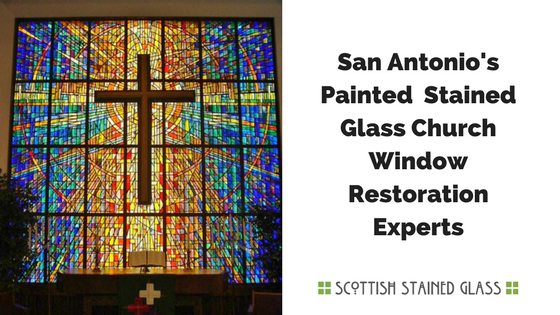
Painted stained glass is no simple process but it is an incredibly rewarding one, with a beautiful outcome that we, at Scottish Stained Glass, have taken years to master. The process for painting stained glass is actually quite fascinating and for one to become proficient in it it takes years of practice. For this reason, we are proud to say that with over 30 years experience in original and restoration stained glass, we are arguably experts. Regardless of whether the painted stained glass in your San Antonio church is old or new, at Scottish, we can successfully take on and complete any type of painted stained glass work. To better understand the intricate processes that go into crafting a one-of-a-kind painted stained glass masterpiece or bringing an old piece back to life, we have outlined a few of the particulars below.
Painted stained glass is a gorgeous and unique way to add character and charm to your San Antonio church–there is no question about that. Your San Antonio church may actually already have some in it right now. Although it may seem like a simple art form, the process can be quite complicated, and make use of chemistry in addition to artistry. This is because colors you see on painted stained glass are brought about through the use of complicated chemical interactions of different minerals and oils.
The artist starts with colored glass and paints special black paint made of oils and minerals onto it. This piece of glass is then fired in our kiln at 1250-1450 for a couple of hours until the paint melts into the glass. The paint then becomes part of the glass and will never rub off or be removed.
The second method involves clear glass. During this process, colors are painted on a clear piece of glass one at a time and fired in between layers of color to build up layers of shading or color. Any color that involves the use of yellow can be particularly difficult in this method as the chemical used for yellows color (silver staining) is very toxic and will destroy other colors. For this reason, when trying to achieve the color green for example, the toxic yellow must be painted on the opposite side of the glass as the blue paint in order to keep the yellow from damaging the blue paint.
Matching styles on restoration projects is definitely a challenge and involves figuring out precisely what type of techniques the original artist employed. For example, sometimes artists would black paint on their glass and then use a wooden stick to rub off part of the black paint–this added unique texture. This same method was also used to scribe in individual elements like blades of glass. Regardless of which techniques the original artist used, our artists work hard to mimic them exactly– sometimes do multiple iterations to get it right.
Learn more about the history of stained glass here or watch the video below.
Difficult as it may be, here, at Scottish Stained Glass, we take great pride in what we do and always love the final, beautiful outcome! Contact us to find out more about original or restoration painted stained glass for your San Antonio Church today!
© Scottish Stained Glass 2000- All Rights Reserved | A Part of Scottish Group Companies